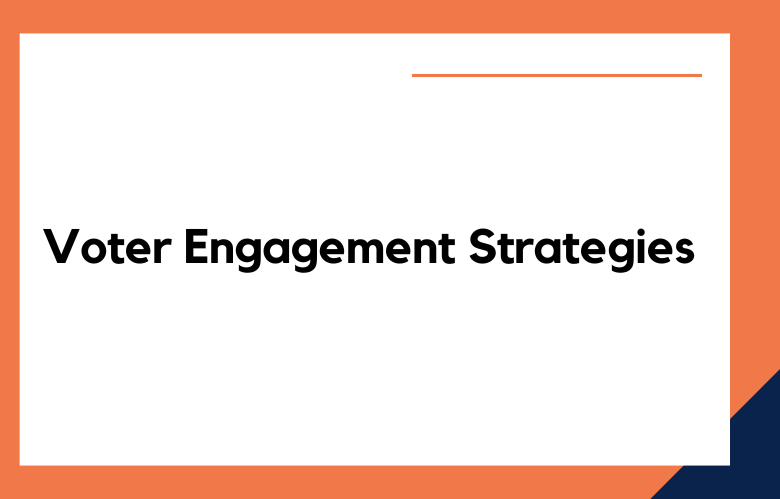Voter engagement strategies are critical to a thriving democracy. Many people feel disconnected from the political process, leading to low turnout rates. An effective plan can bridge the gap between citizens and their representatives.
Engaging voters is about getting them to the polls, building trust, and fostering community involvement. Simple tactics like social media outreach, local events, and informative campaigns can make a huge difference. By using these methods, we can empower individuals and create a more informed electorate. Let’s dive into actionable voter engagement strategies that can spark interest and boost election participation.
Key Takeaways
- Focus on understanding what motivates voters by exploring their needs and concerns to create tailored engagement strategies.
- To enhance voter engagement, implement a mix of outreach methods, such as door-to-door canvassing and community events.
- Analyze data on voter behavior to identify trends and improve your engagement tactics over time.
- Build trust with voters by being transparent, honest, and responsive to their questions and feedback.
- Encourage youth participation by creating programs that resonate with younger voters and highlight the importance of their voices in elections.
Understanding Voter Engagement
Definition and Importance
Voter engagement means getting people involved in the voting process. It includes educating citizens about their rights and encouraging them to vote. Engaged voters often make informed choices, and their participation can change the outcome of elections. Studies show that higher voter turnout leads to better representation of diverse views. Fostering a politically informed citizenry is vital for a healthy democracy. Citizens who understand issues can hold leaders accountable.
Current Trends
Grassroots movements are gaining popularity among voters. These movements focus on local issues and encourage community involvement. More people are joining together to advocate for change. Technology plays a significant role in voter outreach today. Social media platforms help spread information quickly and connect voters with candidates and organizations. Demographic shifts also influence engagement strategies. Younger voters tend to use online platforms more than older generations. This shift requires new approaches to reach them effectively.
Challenges in Engagement
Misinformation is a significant barrier to voter engagement. False information can confuse or discourage potential voters. Apathy, or lack of interest, also affects participation rates. Many people feel their vote does not matter, leading to lower turnout. Disparities exist in access to voting resources as well. Some communities need more accessible access to polling places or information about how to vote.
Reaching younger voters presents its challenges. Many young people need to follow politics more closely. They often rely on social media for news, which can be misleading. Engaging this demographic requires creative strategies that resonate with their values and interests.
Strategies to Enhance Engagement
Digital Platforms Utilization
Social media is a powerful tool for voter outreach. Facebook and Twitter allow campaigns to target specific groups, and engaging posts can spark interest in voting.
Email marketing is another effective method. Sending newsletters keeps voters informed about important dates and issues. Emails can also share resources on how to vote.
Mobile apps also play a crucial role. These apps help users register to vote quickly and can offer educational content about the voting process.
Community Outreach Programs
Local events create spaces for discussions about voting. Town halls or community forums can address voter concerns directly, helping build trust and encouraging participation.
Working with local organizations expands outreach efforts. Groups that represent diverse populations can share vital information. Collaboration increases the likelihood of reaching underrepresented communities.
Door-to-door canvassing is a direct approach. Volunteers knock on doors to talk about voting, and this personal touch can motivate residents to engage in the electoral process.
Educational Campaigns
Informative materials are essential for clear communication. Pamphlets or flyers should explain the voting process.
Webinars provide an interactive way to educate voters. These online sessions can cover various topics, such as ballot measures or candidate platforms. Hosting these allows for real-time questions and answers.
Partnerships with schools promote civic education early on. High school programs can teach students about their rights and responsibilities as voters, and engaging young people fosters lifelong voting habits.
Personalized Communication
Tailoring messages significantly improves engagement rates. Understanding voter demographics allows campaigns to craft specific messages, which makes communication feel more relevant and personal.
Data analytics enhance audience segmentation. By analyzing trends, campaigns can identify which messages resonate best with different groups. This targeted approach leads to more effective outreach efforts.
Personalized follow-ups keep voters engaged throughout the election cycle. Reminders about registration deadlines or polling locations show voters they matter. Consistent communication builds relationships and encourages turnout.
Role of Social Media
Influencer Partnerships
Local influencers can significantly boost voter messages. These individuals have established trust within their communities, and collaborating with them helps spread awareness about voting. Celebrities also play a vital role in this strategy. Their broad reach can draw attention to the importance of participating in elections. For example, when famous figures encourage their followers to vote, it can lead to increased turnout. Trusted community figures add another layer of credibility. They can connect with voters personally, making the message resonate more.
Interactive Content Creation
Interactive content is essential for engaging voters. Quizzes and polls invite participation and spark discussions about voting issues. People enjoy sharing their opinions and learning through these formats. Infographics are another effective tool. They break down complex voting information into easy-to-understand visuals. This makes it simpler for voters to grasp essential details like registration deadlines or ballot measures. Encouraging user-generated content further fosters community involvement. When people share their own experiences or thoughts about voting, it creates a sense of connection and motivates others to participate.
Real-Time Updates
Timely information is crucial during election periods. Voters need to know about registration deadlines and voting procedures. Posting this information on social media ensures it reaches a broad audience quickly. Sharing live updates during elections keeps voters informed about what is happening in real-time. This can include changes in polling locations or unexpected delays. Utilizing push notifications for urgent announcements can also be effective. This direct method grabs attention and ensures that important messages are seen immediately.
Importance of Data Analysis
Voter Behavior Tracking
Tools can track engagement patterns effectively. These tools can reveal how voters interact with campaigns. Monitoring social media interactions helps gauge public sentiment. Analyzing likes, shares, and comments provides insights into what resonates with the audience. Surveys also play a vital role. They help gather information on voter preferences and concerns. This feedback is essential for tailoring messages and strategies.
Feedback Collection Methods
Establishing channels for feedback is essential for voter engagement. Voters should have avenues to share their opinions and experiences. This could include dedicated email addresses or online forums. Conducting focus groups allows for deeper insights into voter needs. These discussions can uncover specific issues that matter to voters. Utilizing online surveys makes collecting feedback efficient. Surveys can reach a larger audience quickly and provide valuable data.
Adjusting Strategies Based on Data
Analyzing collected data is critical to improving voter engagement strategies. Identifying successful tactics helps in refining outreach efforts. For example, if a message gains traction, it can be expanded. Adapting strategies based on voter feedback is essential. If voters express concerns about an issue, campaigns should address these directly. Continuous refinement of strategy leads to better overall effectiveness. Regularly updating approaches ensures that campaigns stay relevant and engaging.
Building Trust with Voters
Transparency in Communication
Openness is vital for building trust with voters. Organizations should clearly explain their goals and methods. This helps voters understand the purpose behind actions. Sharing data and findings with the public can further strengthen this trust. For example, the results should be published if a group surveys voter opinions. This transparency shows that it values voter input.
Communicating how voter feedback influences decisions is essential. When voters see their opinions matter, they feel more engaged. Clear communication fosters a sense of partnership between voters and organizations. It shows that everyone is working towards common goals.
Consistent Messaging Techniques
Uniform messaging across all platforms is crucial. Voters need to hear consistent information to build familiarity. This consistency reinforces vital themes, making messages more accessible and memorable. For instance, if an organization focuses on environmental issues, it should maintain that focus across social media, newsletters, and community events.
Aligning messaging with current events keeps it relevant. If a significant event occurs, organizations should adapt their messages accordingly. This approach helps maintain interest and engagement among voters and shows that organizations know what matters to them at any time.
Addressing Voter Concerns
Listening to voter concerns is a critical step in building trust. Many voters may need clarification about the voting process. Actively seeking out these concerns can help organizations understand what voters need.
It is essential to provide clear, factual responses to common questions. For example, if many voters need clarification about registration deadlines, organizations should address this directly. Offering resources like FAQs or links to official sites helps ease concerns.
Voters often appreciate it when organizations provide tools to help them navigate their worries. These resources can include informational brochures or online guides. By offering support, organizations show they care about voter experiences.
Encouraging Youth Participation
Educational Workshops
These sessions should focus on the electoral process. Participants learn about registration, voting methods, and important dates. Young people need to know how to voice their opinions. Discussions on civic responsibilities help deepen understanding. This knowledge empowers youth to take action in their communities.
Hosting these workshops at schools or community centers makes them accessible. Local organizations can partner with schools to create engaging content. This collaboration fosters a sense of community involvement. Young participants feel more connected when they see local leaders involved.
Engaging School Programs
Schools are ideal places to promote voter engagement. Implementing programs that teach students about voting is essential. These programs can include guest speakers or interactive activities about elections. Student-led initiatives can further inspire participation. For example, students might organize mock elections to practice the voting process.
Partnering with teachers helps integrate voting education into existing curricula. This approach ensures that students learn about civic duties as part of their education. Schools can also host debates on current issues to spark interest in politics.
Leveraging Popular Platforms
ial media offers powerful tools for reaching young voters. Utilizing platforms like Instagram and TikTok can enhance outreach efforts. Engaging with voters through these channels allows for direct communication. Posts should be relatable and informative, capturing the audience’s attention quickly.
Forums and discussion boards are also effective for voter engagement. These platforms allow for open dialogue about important topics. Creating content that resonates with young audiences is vital. Using trendy formats like videos or memes can make the information more appealing.
Incorporating popular apps into outreach strategies will increase visibility. Many young people spend time on these platforms daily. By connecting with them where they already are, organizations can encourage active participation in democracy.
Final Remarks
Voter engagement is crucial for a vibrant democracy. You’ve learned key strategies to boost participation, from leveraging social media to building trust with voters. Engaging youth is essential for the future.
Now, it’s time to take action. Implement these strategies in your community and watch the impact unfold. Encourage friends and family to get involved. Every voice matters. Together, you can create a more engaged and empowered voter base. Don’t wait—start making a difference today!
Frequently Asked Questions
What is AI-powered voter engagement in political campaigns?
AI-powered voter engagement refers to the use of artificial intelligence tools and techniques—like machine learning, natural language processing, and predictive analytics—to personalize and automate outreach, improve targeting, and increase voter interaction throughout a campaign.
How does AI enhance voter segmentation?
AI analyzes vast datasets to identify patterns and segment voters based on behavior, preferences, demographics, and psychographics, allowing campaigns to tailor messages to each segment with higher accuracy.
Can AI predict voter behavior?
Yes, AI uses predictive modeling to anticipate how individuals or groups are likely to vote, respond to issues, or engage with campaign content, enabling strategic planning and micro-targeting.
What role does natural language processing (NLP) play in voter engagement?
NLP helps AI understand and generate human language, enabling chatbots, sentiment analysis of social media, and real-time message personalization across communication channels.
How are AI chatbots used in political campaigns?
AI chatbots engage voters in real time on websites, social platforms, and messaging apps by answering questions, providing updates, and directing users to relevant campaign resources.
What is hyper-personalization in AI-driven campaigns?
Hyper-personalization involves using AI to deliver highly customized messages based on individual data points—like interests, browsing behavior, voting history, and engagement patterns.
How can AI improve voter turnout?
AI can identify voters at risk of abstention, send personalized reminders, and address specific barriers to voting, thereby motivating participation through tailored interventions.
What data sources feed AI in voter engagement platforms?
AI tools use data from social media, past voting records, surveys, website analytics, mobile apps, CRM databases, and public registries to train models and inform campaign strategy.
Are there ethical concerns in AI-based voter engagement?
Yes, concerns include voter manipulation, data privacy breaches, algorithmic bias, and lack of transparency. Ethical use requires clear guidelines, consent mechanisms, and human oversight.
How does AI assist with sentiment analysis in politics?
AI scans digital platforms to analyze public sentiment about candidates, issues, or events—helping campaigns adjust messaging and strategy based on real-time voter mood.
Can AI help with multilingual voter communication?
Absolutely. AI translation tools and language models can generate personalized political messages across multiple languages, expanding reach in diverse constituencies.
What is the role of AI in influencer and community targeting?
AI identifies influential figures within specific communities and analyzes network dynamics to help campaigns leverage social trust and grassroots influence more effectively.
How do AI-powered campaign tools integrate with CRMs?
They sync with campaign CRM systems to update voter profiles, automate workflows, score leads, and measure response rates—ensuring seamless communication cycles.
Is AI used in political fundraising?
Yes, AI predicts which donors are likely to contribute again, customizes donation requests, and automates follow-ups based on behavioral triggers and giving history.
How does AI-driven automation improve outreach efficiency?
Automation enables the delivery of thousands of tailored messages across email, SMS, and social media in real time—reducing manual effort and increasing speed.
Can AI reduce campaign costs?
By streamlining targeting, automating repetitive tasks, and improving message ROI, AI can significantly reduce campaign expenses while increasing outreach quality.
What KPIs are used to measure AI’s impact in voter engagement?
Key metrics include voter conversion rates, engagement levels, response rates, turnout uplift, time saved through automation, and cost-per-engagement.
How do campaigns avoid AI-driven voter fatigue?
By setting intelligent frequency caps, rotating content, and monitoring engagement patterns, AI systems prevent over-communication and maintain message freshness.
What’s the difference between rule-based and AI-driven campaign tools?
Rule-based systems follow fixed logic and templates, while AI-driven tools adapt dynamically based on data patterns, improving over time through machine learning.
What is the future of AI in voter engagement?
The future includes deeper behavioral modeling, real-time conversation agents, predictive mobilization, emotion-aware content delivery, and voice-powered political interactions.











